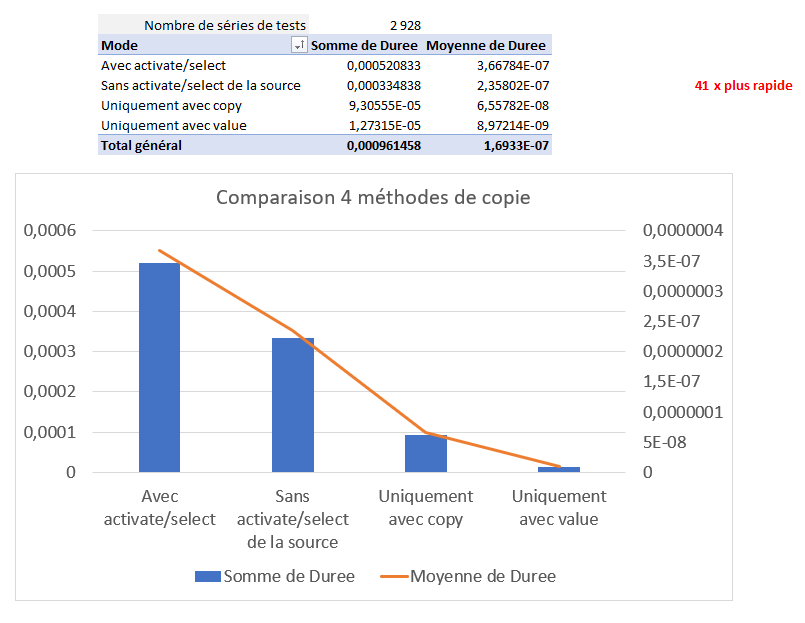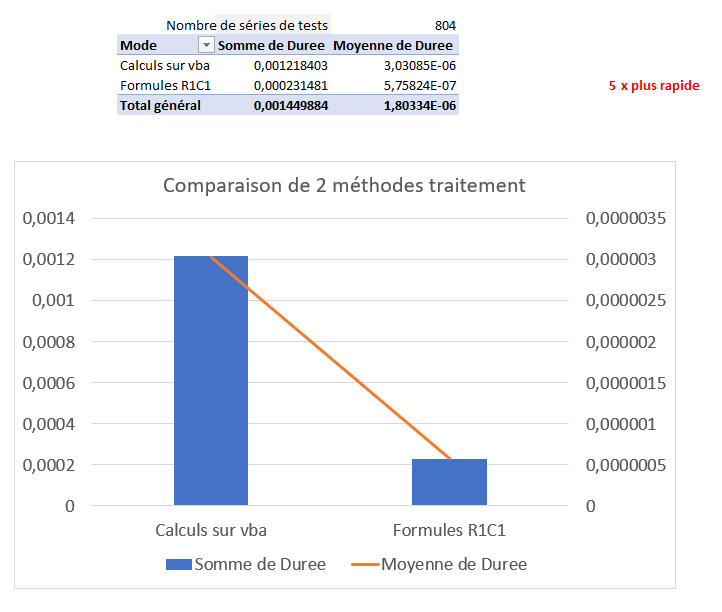Four tips to optimize your VBA code up to 41 times


Automation to save time is great. Optimization in order to minimize the execution time, it’s better ! I’m going to prove to you that by applying my tricks, we can divide the execution time up to 41x 🤯.
Even myself was pretty amazed by this insight.
- My tips
- With and without these tricks : the comparison and the results
- THE optimal method to keep in mind
- Concrete example
- Test source code
My tips
1. Avoid the .Activate method
Even if the recorder helps to create a VBA macro without necessarily knowing how to code…
… Well it’s not quite optimal to stop there !
In fact, the recorder will transcribe each of your manual actions, in particular the fact of selecting a sheet by the Activate method. However, this method is useless in the code, because it is a purely graphical manipulation so that you have the data in front of your eyes. The machine (therefore the code) does not need it.
2. Avoid the .Select method
A range of data is often selected to make a copy (.Copy on the recorder), or to insert a value into it. Again, this selection is an unnecessary graphical manipulation for the code. Use only “.Value =” to assign the value of a data range.
3. Use native functions of Excel Application.WorksheetFunction with R1C1 instead of loops
Speaking of assigning values, it is common that the value to put depends on another cell. Rather than processing the values to be calculated line by line, consider the R1C1 formula solution.
4. Use internal arrays instead of cells
We will often iterate line by line or column by column… But again, looping on graphic elements such as cells is very time-consuming. The solution ? Store the values of the range to process in a local variable. We will see a little later how in the optimal method to keep in mind.
With and without these tricks : the comparison and the results
I set up 4 types of tests:
a) Copy of value : x41 optimization

b) Insertion of several values : optimization x1.6
On 52000 inserted cells, we realize that it is better to first gather the data in a local table before putting them in a data range : this is the ** massive insertion. You save **1.6x more time, and on big data, it can really make a difference.
c) Simple calculations : optimization x5

d) Search for value : optimization x6

Set is used to configure a variable so that it is updated with its reference. Example :
Set value_of_a1 = Range("A1"): if we update the value of cell A1 in Excel, thenvalue_of_a1.Valuewill return this new value.
THE optimal method to keep in mind
If you have to remember 3 things, they are these points:
- Do NOT (or no longer) use : .Activate, .Select, .Copy
- Favor Application.WorksheetFunction and assignment by R1C1 formula with .Value =
- Store the data ranges to be processed in a local variable so as not to iterate directly on the cells.
Concrete example
We want to copy the value of A1 of sheet 1 in lines A1 to A5000 of sheet 2, specifying to the copy the line number of sheet 2 .
Before
Sub before() 'execution time : 22 seconds
Worksheets(1).Activate
Worksheets(1).Range("A1").Select
Selection.Copy
Worksheets(2).Activate
For i = 1 TB 5000
Worksheets(2).Range("A" & i).Select
ActiveSheet.Paste
ActiveCell.Value = ActiveCell.Value&"row"&i
Next
End SubAfter
Sub after() 'execution time : less than 1 second
'declare local variables of explicit names
Dim value_to_copy As String
Dim final_value As String
dim copy_range as string
copy_range = "A1:A5000"
'store in variable without Set
value_to_copy = Chr(34) & ThisWorkbook.Worksheets(1).Range("A1").Value & "row" & Chr(34)
'use the native function =ROW(cell) of Excel
final_value = "=" & value_to_copy & " & " & "ROW(RC1)"
ThisWorkbook.Worksheets(2).Range(copy_range).FormulaR1C1 = final_value
'overwrite formulas with values
ThisWorkbook.Worksheets(2).Range(copy_range).Value = ThisWorkbook.Worksheets(2).Range("A1:A5000").Value
End SubAnd results:
- No loops
- No unnecessary graphical manipulation
- Code commented and with declared local variables
- Easy maintenance by just changing the value of
copy_range - 22x faster
You can get the workbook containing these 2 functions
before/afterhere.
Test source code
I’ve automated all these tests, and I’m making them available to you if you want to take a look : it’s over here and it’s free !
